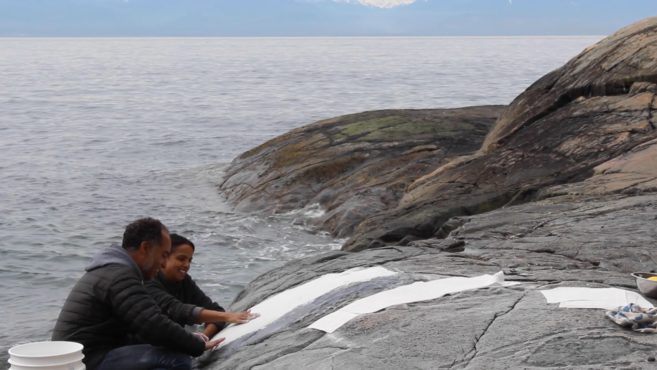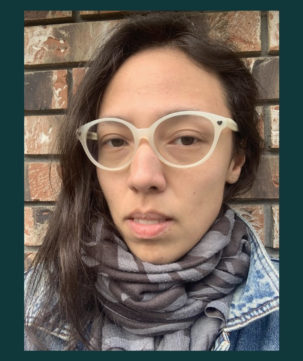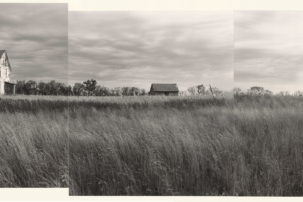Ceramics can have a reputation for being delicate, fragile, porcelain-pale. But Lindsay Montgomery’s artworks in this medium are fierce and fiery, radical and robust, glorious and grotesque.
Goblins, witches and demons are just some of the shadowy elements that she paints on her finely crafted plates, chargers and bowls—not to mention, in several cases, images of the multi-flamed mouth of hell itself.
In the past few months, Montgomery won the Winifred Shantz Award, wrapped a solo show at Montreal’s La Guilde, curated “Kitsch Bitch Witch,” a Minneapolis group show with Brooklyn’s Roxanne Jackson and Long Beach’s Meaghan Smythe, and showed at Papier art fair in April, where her work was featured by Galerie 3 and boosted by Artforum. Through it all, she has continued to teach at Concordia University as well.
This interview with Lindsay Montgomery, edited and condensed from a phone conversation, touches on her influences, origins and hopes for the future—as well as her work shaping the next generation of ceramic artists.
Leah Sandals: How did you start making ceramic work?
Lindsay Montgomery: I started out as a painter. Growing up, I always drew and painted.
When I got to the age of going to university, I enrolled in the craft and design program at Sheridan College, thinking that it was a “practical” alternative to art school—which is kind of crazy to think!
I took glassblowing, and then ceramics. And I fell in love with the latter mostly due to the connection between painting and ceramics found in historical pots.
LS: Did any particular artworks or instructors influence you in school?
LM: When I was in my second year at Sheridan, Walter Ostrom came and did a workshop. He showed us Italian Renaissance Maiolica, which were pieces that were heavily drawn and painted with scenes depicting classical myth and allegory. I fell in love with that work. So when I was finished at Sheridan, I went to NSCAD and and worked closely with Walter, trying to find a way to make it contemporary again.
My more recent work is what I call my “neoistoriato.” Istoriato was made in Italy during the Renaissance and proliferated in Europe in from 16th through to the 19th centuries, and was really focused on storytelling. I saw the potential to come at this ancient craft and storytelling technique from a feminist perspective and talk about current issues that are going on my life and in my world.
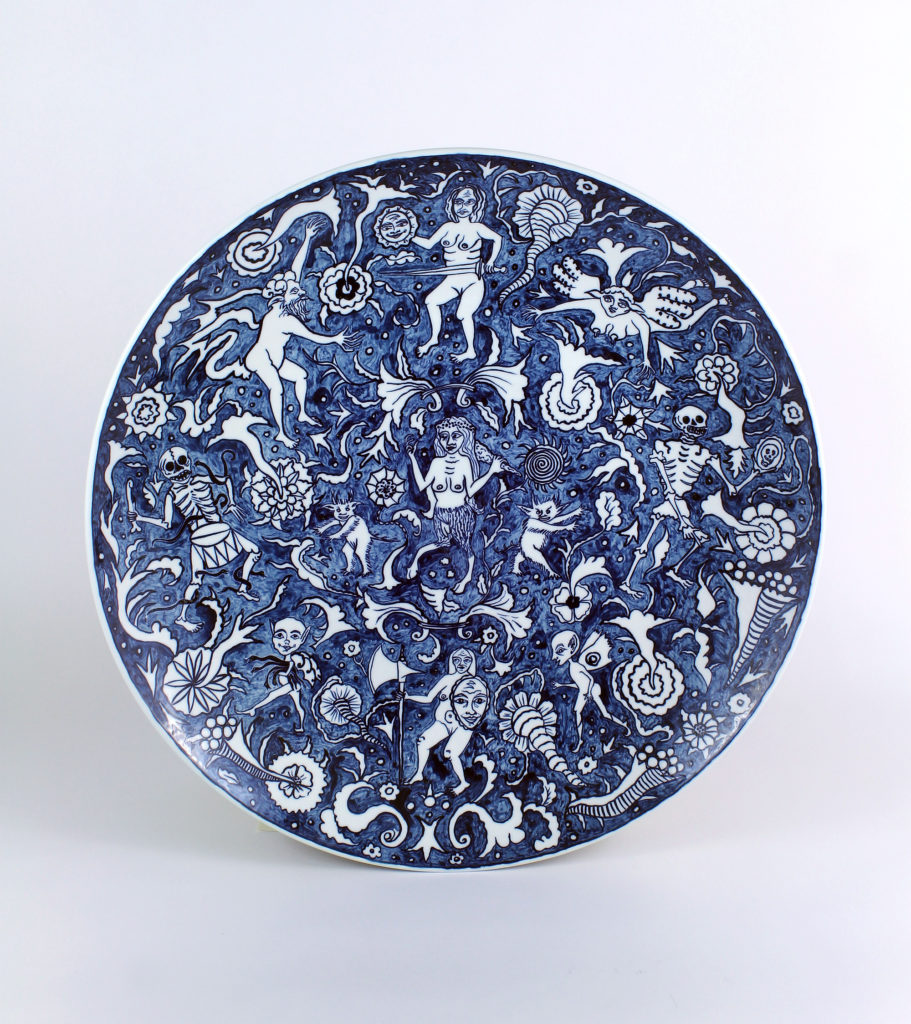 Lindsay Montgomery, Monster Faience 1 - The Resistance, 2018. Press-molded Jingdezhen porcelain, painted with cobalt paste, sprayed clear glaze. 46 cm diameter. Photo: Lindsay Montgomery.
Lindsay Montgomery, Monster Faience 1 - The Resistance, 2018. Press-molded Jingdezhen porcelain, painted with cobalt paste, sprayed clear glaze. 46 cm diameter. Photo: Lindsay Montgomery.
LS: It seems, despite a lot of change, that there is still a divide between “art” and “craft.” Why are ceramics still valued less than paintings and other “fine art” forms, do you think?
LM: When I started out it was sort of unheard of for somebody like me to have garnered attention from contemporary art galleries. But things have really changed in last five years.
A lot of people are finding that contemporary art galleries are really interested in ceramics right now. There is always fear that it’s just a trend and isn’t going to last, but I like to look at it as a reckoning around the division of art and craft that happened so long ago—and that was really gendered discrimination, in my opinion.
I think people are really starting to open their eyes. And anybody looking to combine sculpture and painting should look at ceramics—in ceramics, that practice is part of the history. A lot of the students taking my classes are in sculpture and painting. They are in my class because they are painters who want to work in 3-D, or they want to put painted surfaces on objects.
LS: What artists excite you right now?
LM: There are a bunch of people in ceramics who I’ve looked to forever. But because I’m a Canadian artist, people like Shary Boyle and Daniel Barrow and Kent Monkman come to mind as people working cross-disciplinarily early on.
Shary Boyle in particular was really big for me because she was making feminist work in ceramics, and that work was not valorized in a lot of my education. I mean, the educational standard in ceramics was very much about functional value when I was in training. When I was 22 years old, seeing Shary’s work for the first time, I saw I could make work that was craft and feminist and feminine—all this stuff I was steered away from as a student.
Ceramics people like Betty Woodman have also had a big influence on me, and Ann Agee. I think you find the people you’re in conversation with; I have many influences.
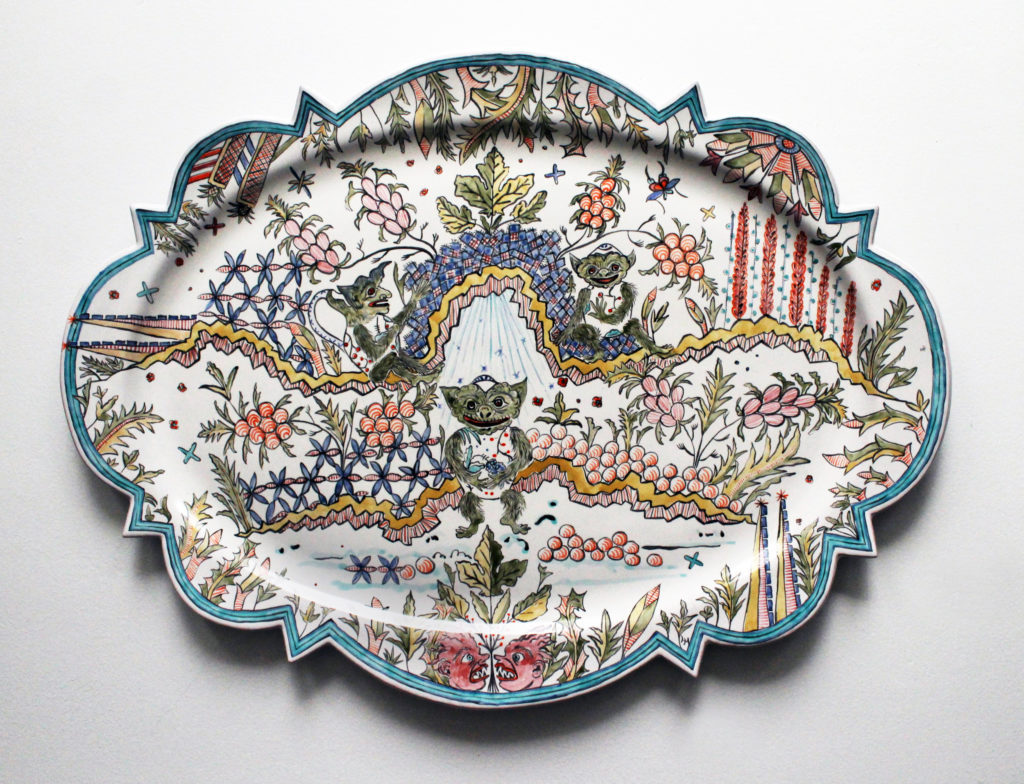 Lindsay Montgomery, Goblin Faience Charger, 2017. Press-molded and tin-glazed earthenware, painted with stains and underglazes, 63 cm across. Photo: Lindsay Montgomery.
Lindsay Montgomery, Goblin Faience Charger, 2017. Press-molded and tin-glazed earthenware, painted with stains and underglazes, 63 cm across. Photo: Lindsay Montgomery.
LS: It’s interesting to me that you find more and more students want to work in ceramics. Why do you think that is?
LM: I think people are really hungry for making again. I find my students really want to make stuff, to get back into material, to think about formal qualities.
I think that conceptual art took over the institution in such a drastic way that at this point it’s radical to be making things out of clay, and things that are encompassing pattern and decoration. It can be used in a really subversive way and still be loaded with all kinds of important content.
For so long we were told “something that is decorative can’t be conceptual”—and that’s just sexist.
LS: The ceramic medium seems pretty demanding to me, as an outsider to it. Do you find it challenging to learn or to teach?
LM: I think there is a myth around that. Because ceramics was so excluded [from mainstream art education and exhibitions], I think a lot of people in the older generations go really full out in saying it takes so much time to understand.
I see those barriers breaking down now. I see people all the time who put their hands in clay and have some affinity for it. There are some basics you have to work around, but it’s not as intimidating as it might look.
Things have come so far: When I started out, we didn’t have computerized digital kilns. To be in ceramics at NSCAD when I was there meant you lived in the building because you had to be checking fire all the time. Now we have kilns you can fire from your laptop at home in bed.
And there’s commercial products now that allow you to have colours and glazes that just weren’t possible 20 years ago. There is still some stigma within the medium in terms of the idea that “people should make their own glazes”—stuff held over from 20th-century studio pottery movement. My students don’t have to take on that history, and I don’t have to either.
I find most of my students have, through an intro class, gotten what they need to go off and start making exciting work of their own.
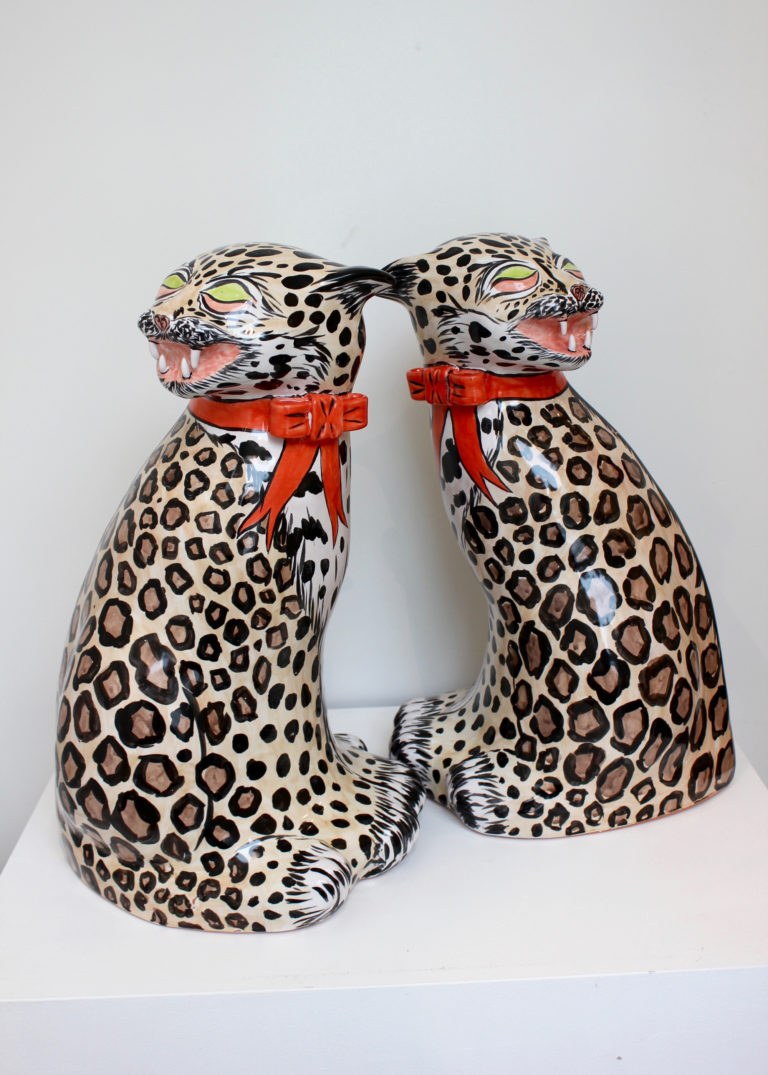 Lindsay Montgomery, Hellcat Foos 2, 2018. Press-molded Jingdezhen porcelain, painted with cobalt paste, sprayed clear glaze. 30 x 58 x 36 cm. Photo: La Guilde.
Lindsay Montgomery, Hellcat Foos 2, 2018. Press-molded Jingdezhen porcelain, painted with cobalt paste, sprayed clear glaze. 30 x 58 x 36 cm. Photo: La Guilde.
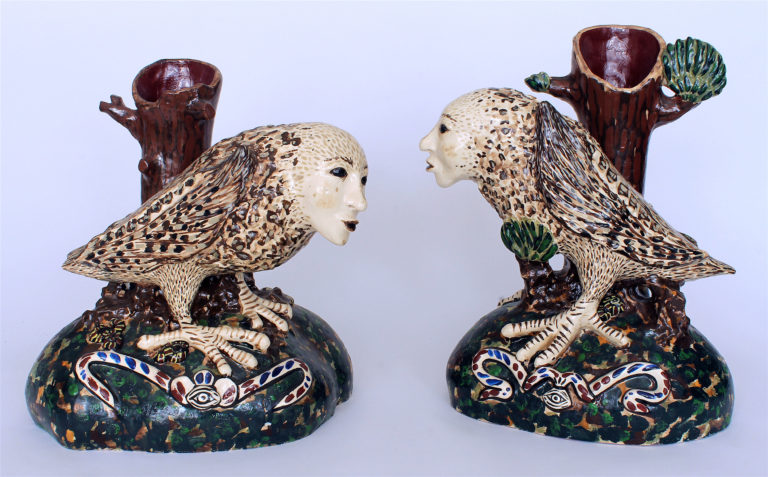 Lindsay Montgomery, Staffordshire Harpies, 2014. Coiled and modelled earthenware, painted with slips, glaze, and over-glaze enamel, 25 x 30 cm and 25 x 35 cm. Photo: Lindsay Montgomery.
Lindsay Montgomery, Staffordshire Harpies, 2014. Coiled and modelled earthenware, painted with slips, glaze, and over-glaze enamel, 25 x 30 cm and 25 x 35 cm. Photo: Lindsay Montgomery.
LS: Your recent show at La Guilde, “Monster Faience,” was a neat mix of old and new. Can you tell me more about what was in that show?
LM: “Monster Faience” was showcasing work I made not only in my studio here in Canada, but also as an artist in residence in China. I spent eight weeks in Jingdezhen last summer working with a team of artists. There, I made work in the same vein of what I normally do, but with really ancient and difficult technology that I would not have been able to use without that expertise and help.
China had a recipe for porcelain hundreds of years before the rest of the world. In the 16th century, all this stuff was coming onto European market, and European people didn’t know how to make it, so they made a fakery of it. I’m really interested in that relationship between their two cultures—in how Europe took this thing and made a cheaper, more readily producible way. But those pieces never quite look like Chinese porcelain, and they pick up on cultural content from European cultures.
LS: What’s next for you?
LM: I have had an unprecedented year—as much interest in the work as I’ve ever had before. There are a few more shows on the horizon. And because I’m the winner of the Winifred Shantz Award I’ll be going to Medalta for two months this summer.
LS: Is there anything else you want people to know when they are looking at your work?
LM: At the heart of everything I do is this idea of storytelling, of mining history. I look at so many different periods of art history, and my work is a collage of all these different times and places. That’s what’s exciting for me about being an artist.
This interview has been edited and condensed.

